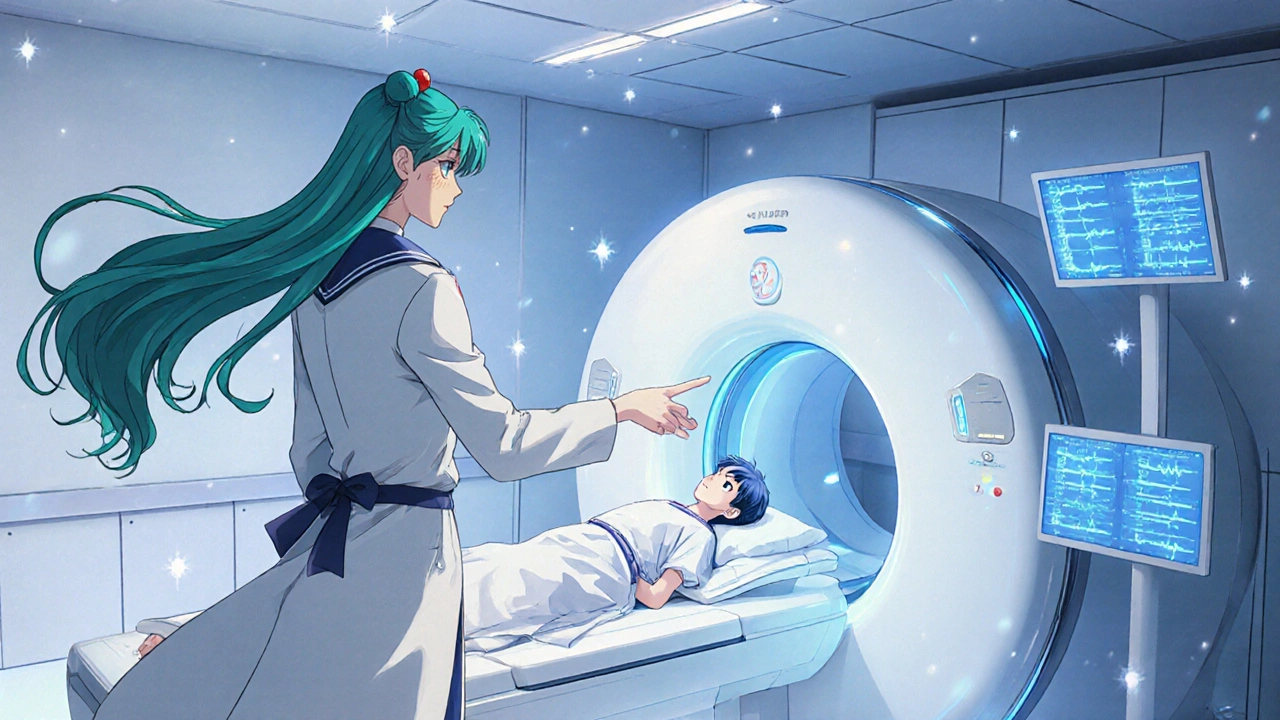TIA Risk Assessment Tool
Risk Assessment Calculator
Estimate your risk of stroke after a TIA based on key medical factors. Remember: Early intervention can reduce your risk by up to 40%.
Note: This tool provides a general estimate. Always consult a healthcare professional for personalized medical advice.
Imagine feeling a sudden numbness in your arm that fades in minutes. Most people brush it off, but that fleeting episode could be a warning sign of a bigger problem. Recognizing transient ischemic attack symptoms isn’t just a medical footnote-it can be the difference between a quick recovery and a life‑changing stroke.
What exactly is a Transient Ischemic Attack?
Transient Ischemic Attack (TIA) is a brief interruption of blood flow to the brain that typically resolves within 24 hours, often in just a few minutes. Because the blockage clears on its own, the damage is usually reversible, but the episode serves as a loud alarm bell for an impending stroke.
Why catching a TIA early matters
Studies from the UK’s National Stroke Registry show that up to 15% of people who experience a TIA will have a full‑blown stroke within three months if no preventive steps are taken. The brain’s blood vessels don’t magically heal; the underlying cause-often a clot or narrowed artery-remains. Early detection gives doctors a chance to intervene before a permanent blockage occurs.
Key warning signs to watch for
- Sudden weakness or numbness, typically on one side of the face or arm.
- Blurred or double vision that comes on quickly and fades.
- Difficulty speaking or understanding speech for a short period.
- Loss of balance, dizziness, or a brief sense of vertigo.
- Severe, sudden headache with no known cause.
These symptoms mirror those of an ischemic stroke but the crucial difference is duration. If symptoms disappear within an hour, think TIA; if they persist, call emergency services immediately.
Common risk factors that set the stage
Understanding why a TIA happens helps you lower the odds. The biggest culprits are:
- High blood pressure - the leading modifiable risk factor.
- Elevated cholesterol levels, especially LDL.
- atrial fibrillation - an irregular heartbeat that can throw clots toward the brain.
- carotid artery disease - plaque buildup narrowing the arteries that feed the brain.
- Diabetes, smoking, and a sedentary lifestyle.
Addressing these factors doesn’t just reduce TIA risk; it slashes the chance of a future stroke by up to 40%.

How doctors confirm a TIA
Even though symptoms vanish, the diagnostic work‑up is thorough:
- MRI (magnetic resonance imaging) - spots tiny brain lesions invisible on CT.
- CT scan - rules out bleeding and quickly checks for major blockages.
- Ultrasound of the neck - evaluates carotid artery disease severity.
- Blood tests - gauge cholesterol, blood sugar, and clotting factors.
- Electrocardiogram (ECG) - detects atrial fibrillation episodes.
These tests create a risk profile that guides treatment.
Immediate actions and treatment options
Once a TIA is confirmed, doctors move quickly:
- Antiplatelet therapy (e.g., aspirin or clopidogrel) to stop platelets from clumping.
- High‑intensity statins to lower LDL cholesterol fast.
- Blood‑pressure‑lowering meds tailored to individual readings.
- If a narrowed carotid artery is the culprit, a surgical carotid endarterectomy or stenting may be recommended.
All of these steps aim to keep another clot from forming and to stabilize the vascular environment.
Long‑term prevention and lifestyle tweaks
Preventing a repeat TIA or a full stroke is a marathon, not a sprint. Here’s a realistic action plan:
- Monitor blood pressure at home; aim for < 130/80 mmHg.
- Adopt a Mediterranean‑style diet rich in fruits, veggies, fish, and whole grains.
- Exercise at least 150 minutes of moderate activity each week-think brisk walking or cycling.
- Quit smoking; nicotine spikes blood pressure and damages vessel walls.
- Limit alcohol to no more than 14 units per week.
- Keep diabetes under control with medication and diet.
Regular follow‑up appointments let your healthcare team fine‑tune medications and catch new risk factors early.

When to call emergency services
If any symptom lasts longer than a few minutes or you’re unsure, treat it like a stroke. Use the FAST mantra:
- Face drooping
- Arm weakness
- Speech difficulty
- Time to call emergency (999 in the UK)
Even if the episode resolves, a professional evaluation is mandatory.
Quick checklist - what to do if you suspect a TIA
- Note the exact time symptoms started and stopped.
- Record which body parts were affected.
- Call 999 or go to the nearest A&E.
- Inform the medical team of any known risk factors (e.g., hypertension, atrial fibrillation).
- Follow up with your GP within 24‑48 hours for further testing.
Comparison: TIA vs Full‑Blown Stroke
| Feature | Transient Ischemic Attack (TIA) | Ischemic Stroke |
|---|---|---|
| Duration of symptoms | Minutes to < 24 hours (usually < 1 hour) | Persistent, > 24 hours |
| Brain damage | Usually none (reversible) | Permanent tissue loss |
| Immediate risk | High risk of subsequent stroke | Life‑threatening, requires emergent care |
| Treatment window | Hours to days (preventive meds, surgery) | Minutes to hours (thrombolysis, thrombectomy) |
| Typical diagnostic tools | MRI, CT, carotid ultrasound, ECG | CT (to rule out bleed), MRI, angiography |
Frequently Asked Questions
Can a TIA happen without any known risk factors?
Yes, although uncommon. Occasionally a clot forms spontaneously, especially in younger adults with rare clotting disorders. Still, a thorough medical review often uncovers a hidden factor like mild hypertension or undiagnosed atrial fibrillation.
Is it safe to drive after a TIA?
No. Most licensing agencies, including the DVLA in the UK, require a medical clearance after any neurological event. Driving while symptoms linger increases accident risk.
How quickly should I start medication after a TIA?
Ideally within 24‑48 hours. Early antiplatelet therapy and statins have been shown to cut 90‑day stroke risk by about 30%.
Can lifestyle changes alone prevent a second TIA?
Lifestyle tweaks dramatically lower risk but are usually combined with medication for the best outcome. A person who quits smoking, controls blood pressure, and follows a heart‑healthy diet can reduce their 5‑year stroke risk to under 5%.
What’s the difference between a TIA and a mini‑stroke?
“Mini‑stroke” is a lay term often used interchangeably with TIA. Medically, a TIA is defined by symptom duration (<24 hours) and lack of permanent damage, whereas a mini‑stroke may imply a small, but lasting, stroke.

Rachel Valderrama
October 21, 2025 AT 19:00Wow, another chance to brag about how easy it is to miss a mini‑stroke.
But seriously, those fleeting numbness episodes are the universe's way of shouting, "Pay attention!"
Grab a pen, note the time, and don’t let it become a full‑blown emergency.
Brandy Eichberger
October 24, 2025 AT 02:33One must appreciate the intricacy of cerebrovascular dynamics; a transient ischemic attack, though brief, is a profound reminder of mortal fragility.
Embracing preventive vigilance is not merely advisable-it is an intellectual imperative for the discerning mind.
eric smith
October 26, 2025 AT 09:07Look, if you think a few minutes of arm tingling is just “stress,” you’re basically inviting a stroke to your doorstep.
Medical literature, not my opinion, says that TIAs are the canary in the coal mine-ignore them and you’re asking for trouble.
Ericka Suarez
October 28, 2025 AT 16:40Listen up, folks! This is not some foreign conspiracy-our own bodies are warning us.
It’s simple: you feel a weird numbness, it fades, and bam-you’ve just had a TIA.
Dont be lazy, get checked or you’ll be paying the price later.
America deserves better than a nation that ignores its own health signals.
Jake Hayes
October 31, 2025 AT 00:13If you ignore a TIA, you’re practically courting a stroke.
parbat parbatzapada
November 2, 2025 AT 07:47They dont want you to know how easy it is to spot a TIA-big pharma and the media keep it hidden.
But i can see through the fog, and i tell ya, that one‑minute numbness is a secret alarm that most people ignore because they trust the system too much.
Casey Cloud
November 4, 2025 AT 15:20From a practical standpoint, the first thing you should do after a suspected TIA is to log the exact onset and resolution times.
Then, schedule an expedited MRI and carotid ultrasound-don’t wait for your GP to get back to you.
Early antiplatelet therapy, preferably within 24‑48 hours, can cut the 90‑day stroke risk by a third.
Also, keep a home blood pressure cuff handy; the target should be below 130/80 mmHg.
Eli Soler Caralt
November 6, 2025 AT 22:53yeah, i get the vibe that we’re all overthinking this, but honestly, getting that scan ASAP is the only rational move.
the brain doesn’t care about our schedules, so why should we?
Eryn Wells
November 9, 2025 AT 06:27Great point, Brandy! 🌟 It’s amazing how a quick check can save lives, and sharing that knowledge feels like a small act of kindness. 🙏
Kathrynne Krause
November 11, 2025 AT 14:00Exactly! 🚀 Let’s turn that knowledge into action-encourage friends to get their BP checked, swap recipes for heart‑healthy meals, and remind everyone that a fleeting numbness isn’t “just a thing.” 🎉
Chirag Muthoo
November 13, 2025 AT 21:33It is highly recommended that individuals experiencing transient neurological symptoms seek immediate professional evaluation in accordance with established clinical protocols.
Angela Koulouris
November 16, 2025 AT 05:07Hey, you’ve got this! Remember to take deep breaths, stay positive, and keep that follow‑up appointment on your calendar.
Harry Bhullar
November 18, 2025 AT 12:40Let’s break this down step by step, because understanding the cascade of events after a transient ischemic attack can empower you to take decisive action.
First, recognize that a TIA is essentially a brief, self‑limiting blockage of blood flow to a portion of the brain, often lasting less than an hour.
This fleeting episode produces neurologic deficits that mimic a full‑blown stroke-weakness, speech difficulty, visual disturbances-yet resolves spontaneously, which sometimes leads to complacency.
However, that very resolution is deceptive; the underlying atherosclerotic plaque or cardiac embolus remains, and the risk of a subsequent stroke spikes dramatically within the next 48 hours to 90 days.
In fact, epidemiological data indicate that up to fifteen percent of patients will suffer a major ischemic stroke within three months if no preventive measures are instituted.
Therefore, the diagnostic work‑up must be initiated without delay.
High‑resolution MRI is the gold standard for detecting acute ischemic lesions that may not be apparent on CT, while CT angiography can quickly assess large‑vessel occlusions and rule out intracerebral hemorrhage.
Carotid duplex ultrasonography evaluates for stenosis in the extracranial carotid arteries, a common source of emboli.
Simultaneously, a 12‑lead ECG and prolonged cardiac monitoring are essential to uncover occult atrial fibrillation, a potent source of cardioembolic events.
Blood work should encompass a full lipid panel, fasting glucose, HbA1c, and coagulation studies to identify modifiable risk factors.
Once the etiology is clarified, antiplatelet therapy-typically aspirin or clopidogrel-should be started within twenty‑four hours to inhibit platelet aggregation.
Statins, particularly high‑intensity regimens like atorvastatin 80 mg, have been shown to reduce recurrent stroke risk by stabilizing vulnerable plaques and improving endothelial function.
Blood pressure control is paramount; most guidelines recommend a target below 130/80 mmHg, achieved with ACE inhibitors, calcium channel blockers, or diuretics as appropriate.
In cases of significant carotid stenosis (>70 %), surgical carotid endarterectomy or percutaneous stenting offers a substantial reduction in future stroke risk.
Beyond pharmacologic and procedural interventions, lifestyle modifications are indispensable: adopt a Mediterranean diet rich in omega‑3 fatty acids, engage in at least 150 minutes of moderate aerobic activity weekly, cease tobacco use, and limit alcohol consumption to moderate levels.
Regular follow‑up appointments enable clinicians to fine‑tune therapy, monitor adherence, and reassess risk profiles over time.
Finally, educate patients and families on the FAST criteria-Face drooping, Arm weakness, Speech difficulty, Time to call emergency services-so that any future neurologic event is addressed with the urgency it warrants.
Dana Yonce
November 20, 2025 AT 20:13Wow, that was a lot! 🤯 Thanks for breaking it down so clearly.
Lolita Gaela
November 23, 2025 AT 03:47From a pathophysiological perspective, the transient interruption of cerebral perfusion precipitates a cascade of excitotoxic neuronal injury, underscoring the necessity for rapid antithrombotic initiation and secondary prevention strategies.